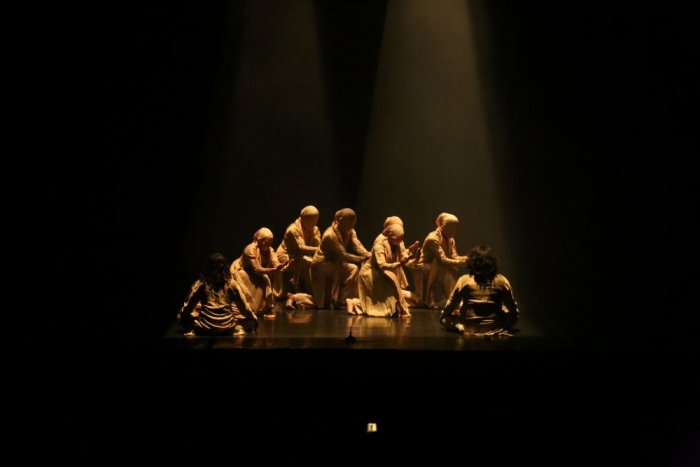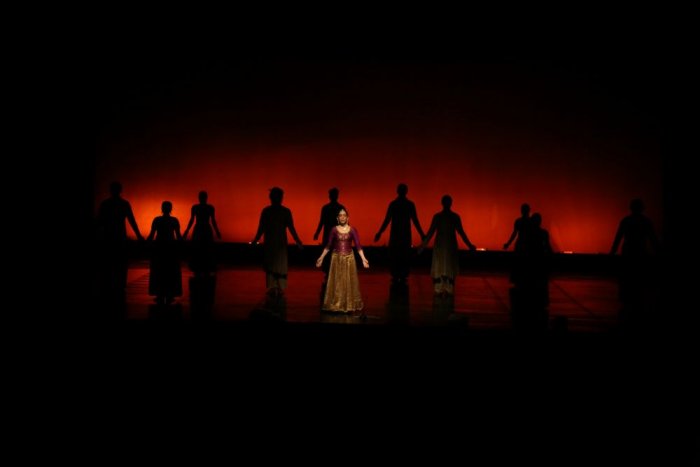
|   |

|   |
Aditi Mangaldas' 'Knotted' and 'Unwrapped' - A journey through chaos, silence, and self - Madhur Gupta e-mail: madhurgupta04@gmail.com May 8, 2025 Some performances don't just fill a stage - they reach inside you, rearrange something, and leave you quietly altered. Watching Aditi Mangaldas' Knotted and Unwrapped was exactly that kind of experience. These two works, presented with her ensemble, traverse a landscape of rupture and recovery, confinement and freedom. Rooted in Kathak but expanding far beyond its classical boundaries, they felt like emotional excavations - urgent, precise, and hauntingly beautiful. Knotted Knotted begins in chaos. Dancers run across the stage, their bodies caught in heaving, fragmented movement. There's no narrative to hold onto, and the music - disjointed, sometimes absent - offers no rhythm to rest in. It's unsettling. A sudden, sharp stop brings an odd relief, as if the stage itself has gasped. In one unforgettable moment, a loud clap cuts the silence - violent in its clarity. It's followed by a striking sequence with Dheerendra Tiwari and Gaurav Bhatti, clapping with such force and synchronization that it feels less like rhythm and more like confrontation.  Knotted (Photo: Innee Singh & Team) The lighting remains dim, almost conspiratorial, cloaking the dancers in shadow. A question lingers - is this carefully constructed, or is it just emotion breaking through form? Either way, it holds us completely. A duet between Aditi and Gaurav follows - no music, just silence that grows heavier with every movement. She's the puppet, trapped in a web of invisible strings. He manipulates, and she collapses. Their performance becomes a portrait of inner torment, unspoken but unmistakable. Then, the space expands. Light begins to seep in. Ten dancers fill the stage. Tabla rhythms surface, grounding the piece for a moment, but the turbulence remains. Aditi enters holding a feather - sometimes impossibly heavy, sometimes weightless - and with it, a potent metaphor for the shifting burdens we carry. In a chilling sequence, a searchlight scans the stage, revealing what appear to be lifeless bodies. Aditi stands in the center, hair wild, caught in a spinning circle - a woman bound by grief, memory, and the relentless turning of time. The circle widens, but she never escapes. There is a visceral sense of loss, of madness just beneath the surface. At one point, all dancers cover their faces, and Aditi ends with her hands over her mouth - silenced and contained, as if the act of expression itself is forbidden. And somewhere in all this intensity, you find yourself wondering: Why does the Indian audience clap in the middle of such moments? Is it release? Habit? Politeness? Discomfort? Unwrapped If Knotted was an implosion, Unwrapped is a slow exhale. It begins with faces veiled, steps hushed. Two pakhawaj players sit center stage, grounding the atmosphere with deep, resonant strokes. There's no rush here - just space, and time.  Unwrapped (Photo: Innee Singh and team) The tatkar begins, exploratory rather than emphatic. The dancers glide, their feet speaking in fragments - bits of toda, tukda, stray syllables: "Ya ali la lom tom nom." A subtle alignment of sound and motion builds and then lands - perfectly - on sam. The spotlight locks in, and everything goes still. Aditi sits between two pakhawaj players. A mirror motif appears - echoing both her image and her inner life. A vocalist replaces the percussion, and Aditi begins to speak: "Ghina tita kata gadigina... Wrapped in yourself... You hid from me. All day I looked for you." It no longer feels like performance. It's confession. She peels back layers - cloth, choreography, perhaps even identity. "Wrapped" becomes a metaphor for what we hide, even from ourselves. As the tabla returns, six dancers gently advance in tatkar. Wraps come off, one by one. The thaat is delicate. Mohit Gangani's tabla pulses underfoot. Dancers pair off - male-male, female-female, male-female - facing each other in rhythmic challenge. It's playful, yet pointed. There's joy in the clarity.  Unwrapped (Photo: Innee Singh and team) The final act is luminous. A rich orange cyclorama lifts as Aditi performs a solo interwoven with Kabir's doha - "Kahat Kabira Sadhu...". She sits and recites, interspersing philosophy with fierce footwork, her body becoming both drum and voice. Her stamina, precision, and presence are undeniable. She is - as one might say - fit af. The closing is tender. "Wrapped up, you hid from me. All day I looked. And when I found you, I ran wild. Playing... now... you... now... you." The dancers return, seated in a shared padhant. Their tukras are spirited, communal - almost celebratory. What began as concealment ends in togetherness. Aditi's final fading tatkar, alone in a soft pool of light, becomes a heartbeat - quiet, certain, human. Aditi Mangaldas is not simply performing Kathak - she is reshaping its possibilities. These two works reveal the fragility and fire of the human experience through live music, minimalist staging, and deeply embodied emotion. They challenge us to sit in discomfort, to listen to silence, and to recognize the beauty in unravelling. And behind it all, there is the quiet presence of the late Kumudini Lakhia (Kumiben) - mentor, innovator, legacy. You can feel her influence in every pause, every risk, every refusal to stay still. The performance was presented by KNMA (Kiran Nadar Museum of Art). These were not just performances. They were acts of remembering, resisting, and becoming.  Madhur Gupta is currently in advanced training under Guru Sharon Lowen in Guru Kelucharan Mohapatra style of Odissi. He is the author of the bestselling book 'Courting Hindustan' published by Rupa Publications, while he also has the unique honour of being featured on National Geographic for a show titled 'No Filter' to his credit. Madhur is the founder of Sangeet Vidya Niketan in New Delhi. |